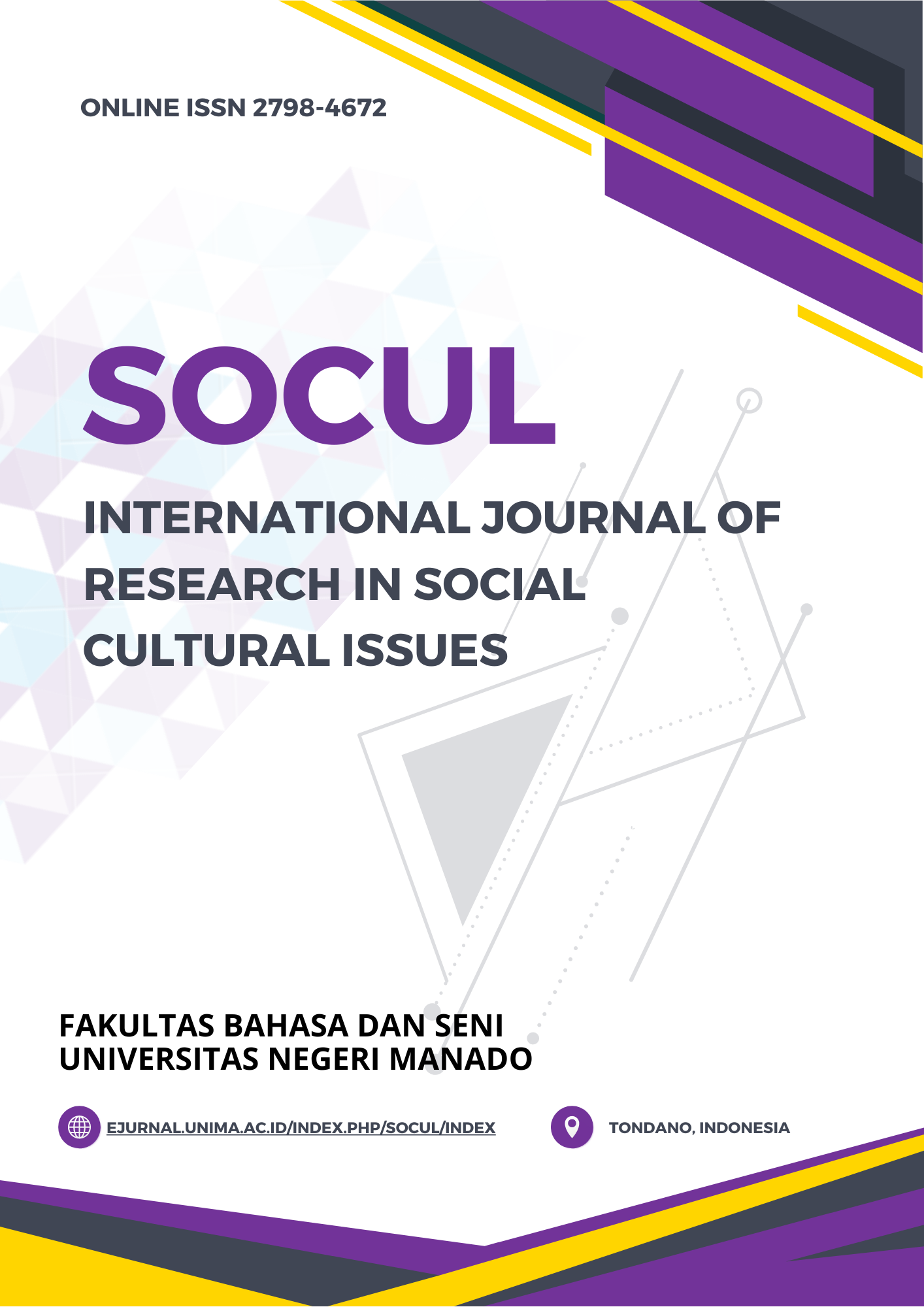THE IMPACT OF PIRACY IN ELIZABETH RUDNICK’S PIRATES OF THE CARIBBEAN: THE CURSE OF THE BLACK PEARL
Keywords:
The Impact of Piracy, Elizabeth Rudnick, Literature AnalysisAbstract
The objective of the present study is to find out the impact of piracy in Elizabeth Rudnick’s novel Pirates of the Caribbean: The curse of the Black Pearl. The methodology, which the writers applied in this research, is the qualitative method with the mimetic approach to analyze the data. The source of the data in this research is Elizabeth Rudnick’s novel Pirates of the Caribbean: The Curse of the Black Pearl which was published by Disney Press, in 2006. The result of this research shows that piracy affects the human and the environment. Piracy also affects the underwater ecosystem and creates pollution. It is suggested that more investigation be done to examine the larger effects of piracy on both the natural environment and human settings. To lessen the harmful effects of piracy on the underwater ecosystem and minimize contamination, initiatives should also be made to increase awareness and encourage responsible behavior.
References
Abadinsky, H. (2012). Organized crime. Cengage Learning.
Alamsyah, A., Supriyono, A., Mualimin, M., & Maziyah, S. (2023). Between Maritime Tradition and Violence on the Sea: Local Response to the European Expansion in Indonesia. Journal of Maritime Archaeology, 18(1), 65-83.
Ali, K. D. (2015). Maritime security cooperation in the Gulf of Guinea: Prospects and challenges.
Aloyo, E., & Andrew, L. (2010). The Economic cost of maritime piracy. One Earth Future Working Paper.
Baldauf, S. (2010, January 18). Somali pirates fight over record ransom. Available at https://www.csmonitor.com/World/Africa/2010/0118/Somali-pirates-fight-over-record-ransom.
Booth, W. C. (1983). The rhetoric of fiction. University of Chicago Press.
Boyd, R. L., Blackburn, K. G., & Pennebaker, J. W. (2020). The narrative arc: Revealing core narrative structures through text analysis. Science advances, 6(32), eaba2196.
Cawthorne, N. (2005). Pirates: An Illustrated History. Arturus Publishing Ltd.
Chalk, P. (2008). The maritime dimension of international security: terrorism, piracy, and challenges for the United States (Vol. 697). Rand Corporation.
Collins, V. E. (2016). Somalis fight back: Environmental degradation and the Somali pirate. In Environmental Crime and Social Conflict (pp. 153-174). Routledge.
Daniels, C. L. (2012). Somali piracy and terrorism in the Horn of Africa (Vol. 1). Scarecrow press.
Davidson, H. E. (2023). The Viking Road to Byzantium (Vol. 18). Taylor & Francis.
Desmawati, E. (2020). Analysis of feminism in the novel of little women by Louisa May Alcott. Journal of Language and Literature, 6(2), 91-96.
Duru, O. (2014). Irrationality in politics and governance of maritime affairs: The collapse of sovereign maritime governance. International Journal of e-Navigation and Maritime Economy, 1, 48-59.
Eisner, M. (2009). The uses of violence: An examination of some cross-cutting issues. International Journal of Conflict and Violence (IJCV), 3(1), 40-59.
Emanuel, J. P. (2020). The End of the Bronze Age and Beginning of the Iron Age in the Eastern Mediterranean. In Naval Warfare and Maritime Conflict in the Late Bronze and Early Iron Age Mediterranean (pp. 197-263). Brill.
Fu, X., Ng, A. K., & Lau, Y. Y. (2010). The impacts of maritime piracy on global economic development: the case of Somalia. Maritime Policy & Management, 37(7), 677-697.
Hamza, F. R., & Priotti, J. P. (2020). Maritime trade and piracy in the Gulf of Aden and the Indian Ocean (1994–2017). Journal of transportation security, 13, 141-158.
Heller-Roazen, D. (2009). The Enemy of All: Piracy and the Law of Nations. Zone Books.
Hoang, A. T., Bui, X. L., & Pham, X. D. (2018). A novel investigation of oil and heavy metal adsorption capacity from as-fabricated adsorbent based on agricultural by-product and porous polymer. Energy Sources, Part A: Recovery, Utilization, and Environmental Effects, 40(8), 929-939.
John, M. A. K. C., Saeed, O., Malik, K., Ahmed, T., & Sami, M. (2023). Characterization As A Rhetorical Device In The Crafting Of Ice Candy Man As A Bildungsroman. Journal of Positive School Psychology, 7(6), 622-639.
Kang, J. A., Hong, S., & Hubbard, G. T. (2020). The role of storytelling in advertising: Consumer emotion, narrative engagement level, and word‐of‐mouth intention. Journal of Consumer Behaviour, 19(1), 47-56.
Kraska, J. (2010). Freakonomics of maritime piracy. The Brown Journal of World Affairs, 16(2), 109-119.
Kundera, M. (2020). The art of the novel. Faber & Faber.
Lehr, P. (2013). Somali piracy and international crime. Globalizing Somalia: Multilateral, International and Transnational Repercussions of Conflict, 116-38.
Lehr, P. (2019). Pirates. Yale University Press.
Linebaugh, P. (2009). The Magna Carta manifesto: Liberties and commons for all. Univ of California Press.
Lucie-Smith, E. (1978). Outcasts of the Sea: Pirates and Piracy. Paddington Press
Maru, M. G. (2009). Engaging Literary Text to Language Exposures for Foreign English Learners. In International Conference on TEFL/COTEFL in Muhammadiyah University.
McNeill, J. R., & Engelke, P. (2016). The great acceleration: An environmental history of the Anthropocene since 1945. Harvard University Press.
Meniketti, M. (2020). The Bush Hill Sugar Plantation: A West Indies Case Study in Developmental Capitalism. Historical Archaeology, 54(1), 212-239.
Mittenentzwei, S., Weiß, V., Schreiber, S., Garrison, L. A., Bruckner, S., Pfister, M., ... & Meuschke, M. (2023, June). Do disease stories need a hero? Effects of human protagonists on a narrative visualization about cerebral small vessel disease. In Computer Graphics Forum (Vol. 42, No. 3, pp. 123-135).
Møller, B. (2008). Piracy, Maritime Terrorism and Naval Strategy. Copenhagen: Danish Institute for International Studies, November 16.
Mulatsih, M. V. E. (2020). Introduction to prose in English language teaching. Sanata Dharma University Press.
Ning, Y., Xu, S. X., Yan, M., & Huang, G. Q. (2018). Digital pricing with piracy and variety seeking. International Journal of Production Economics, 206, 184-195.
Nodelman, P. (2008). The hidden adult: Defining children's literature. JHU Press.
Nwadigwe, C. E. (2018). Creativity and New Technologies: Piracy, Politics and the Business of Cultural Production in Nigeria. Africa and Globalization: Challenges of Governance and Creativity, 183-204.
Nwalozie, C. J. (2020). Exploring contemporary sea piracy in nigeria, the niger delta and the Gulf of Guinea. Journal of Transportation Security, 13(3-4), 159-178.
Onuoha, F. C. (2010). Piracy and maritime security off the Horn of Africa: Connections, causes, and concerns. African Security, 3(4), 191-215.
Otto, L. (2011). Benefits of buccaneering: The political economy of maritime piracy in Somalia and Kenya. African Security Review, 20(4), 45-52.
Pallardy, R. (2010). Deepwater Horizon oil spill. Available at https://www.britannica.com/event/Deepwater-Horizon-oil-spill.
Pattiwael, A. S. (2019, January). Literature for Developing Student's Humanity Awareness. In Journal International Seminar on Languages, Literature, Arts, and Education (ISLLAE) (Vol. 1, No. 1, pp. 79-88).
Pennell, C. R. (2010). The Geography of Piracy: Northern Morocco in the Mod-Nineteenth Century. C. R. Print.
Re, V. (2018). Anti-piracy policies and online film circulation. Digit. Piracy A Glob. Multidiscip. Acc, 52.
Reid, J. L. (2015). The Sea Is My Country: The Maritime World of the Makahs, an Indigenous Borderlands People. Yale University Press.
Rorintulus, O. A., Manuas, M. J., & Tuerah, I. J. (2022). Exploring Environmental Damage in Novel The Color Purple by Alice Walker and Bekisar Merah by Ahmad Tohari: A Literature Ecocritics Review. Journal of English Language Teaching, Literature and Culture, 1(2), 109-118.
Rudnick, E. (2006). Pirates of the Caribbean: The curse of the Black Pearl. Disney Press.
Starkey, D. J. (2022). British privateering enterprise in the eighteenth century. Liverpool University Press.
Struett, M. J. (2018). Maritime Piracy and Global Security. Transnatl. Crime Glob. Secur. 2 (23).
Teitler, G. (2002). Piracy in Southeast Asia: a historical comparison. Maritime Studies, 1(1), 67-83.
Wenar, L. (2008). Property rights and the resource curse. Philosophy & public affairs, 36(1), 2-32.
Yancey, D. (2012). Piracy on the High Seas. Greenhaven Publishing LLC.













